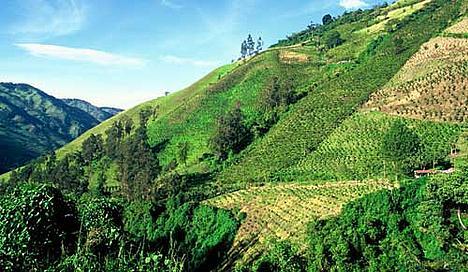Today more than ever we need to be firm in our conviction that Colombia will be better off with peace than with war. This outlook applies across the board — in the social, economic and environmental spheres.
The armed conflict has left an immense ecological footprint and has limited the extent to which Colombia can achieve development through biodiversity.
There are many examples of the conflict’s direct impact on goods and services that derive from nature: the planting of landmines (Colombia has the second largest number of victims after Afghanistan); violent incidents in protected areas; deforestation caused by the expansion of illicit crops (42 percent of national parks have been affected by illegal coca crops); the growth of illegal mining (86 percent of gold production in the country comes from illegal sources); deforestation and soil degradation (erosion related to deforestation in municipalities affected by the conflict is around 430,000 hectares), among others.
Let’s look into the opportunities that peace can bring.
First, the environment has proven essential for achieving post-conflict reconciliation and stabilization across the globe. Rwanda for example, where more than a million people lost their lives in the genocide in the 1990s, offers some interesting experiences in this regard. Through a national program, hundreds of prisoners were involved in community and environmental projects such as reconstruction of schools and health centers, building terraces to stop landslides, and participating in reforestation activities. These activities helped to integrate former combatants into productive work and laid the foundation for their reconciliation with Rwandan society.
In a recent interview, Colombia’s Minister of Environment Luis G. Murillo expressed the government’s intention to include former combatants of the Revolutionary Armed Forces of Colombia in forest conservation projects, helping safeguard some of the most important ecosystems in the country. In a culturally and biologically diverse country such as Colombia, such resources are of paramount importance, and these initiatives should be strengthened.
The second opportunity relates to pursuing more concerted efforts to overcome social and institutional constraints. The geographical areas most seriously affected by the conflict — often the most biodiverse territories in Colombia — are also those with the highest unsatisfied basic needs indicators, the method that identifies critical gaps in housing, sanitation, education and economic capacity.
Those regions also have also the greatest needs for institution building in local environment policy. However, financial resources for these entities have been on the decline. In 2012, the budget for Colombia’s National Environmental System was one-third of what it was in 1998. Country members of the Organization for Economic Cooperation and Development assign 1-2 percent of the national budget to these purposes, while in Colombia this amount is less than 0.6 percent.
Peace is an opportunity to showcase the environmental potential of these Colombian regions in addition to generating dynamic economic and social development. Government agreements with the FARC guerrilla movement, combined with the new social and political dynamics of a post-conflict, would generate the conditions necessary to boost rural economies. This can happen with the participation of victims of the conflict, former combatants, and community organizations. Plus, it is an opportunity to improve the competitiveness of these regions, through new initiatives such as agro-tourism and ecotourism, bioprospecting, payment for ecosystem services initiatives and so forth.
The third environmental opportunity has to do with achieving more and better markets for products deriving from biodiversity. The international market of biotrade products is around $141.3 billion per year, without ecotourism. Colombia accounts for just $25 million per year.
Across Latin America and the Caribbean, tourism is closely linked to the environment; a recentU.N. Development Program dubbed the region a “biodiversity superpower.” Indeed, 70 percent of tourists visit natural areas. In the Caribbean, 94 percent of tourism businesses depend on the environment for their livelihood.
However, Colombia has been falling in global rankings of tourism competitiveness in the specific topic of natural resources (place 5 in 2009 to 24 in 2015). This shows an important challenge to take advantage of the immense opportunities the country has thanks to its biodiversity and ecosystem — treasures that are going to be more accessible after the conflict.
The fourth opportunity revolves around how the implementation of the peace accords will provide the perfect scenario for bringing about the 2030 Agenda for Sustainable Development, that is, ensuring more rapid fulfillment of the Sustainable Development Goals.
The international community has shown considerable confidence and interest in Colombia, as illustrated for example at COP21 in Paris with the agreement between the Colombian government, Germany, Norway and the United Kingdom to introduce results-based payments for reducing deforestation. Peace will accelerate the implementation of this agreement and various other initiatives.
In this context, it is crucial to reduce gender gaps and empower women in post-conflict settings, as such efforts will expedite fulfillment of all the goals relating to development, peace and the environment.
We must aspire to achieve a Colombia without conflict, a country that is prosperous and sustainable, and leaves no one behind.
Source: Devex











